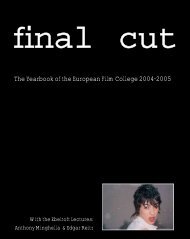yearbook 2004/05 - The European Film College
yearbook 2004/05 - The European Film College
yearbook 2004/05 - The European Film College
You also want an ePaper? Increase the reach of your titles
YUMPU automatically turns print PDFs into web optimized ePapers that Google loves.
FROM THE STUDENTS<br />
[<strong>The</strong>] artists were controlled by what the producers<br />
thought, the producers were controlled<br />
by what the distributors thought (or what producers<br />
expected the distributors would think),<br />
distributors were controlled by what they<br />
thought the cinema owners thought and the<br />
cinema owners were controlled by what they<br />
thought the audience wanted.<br />
But what does the audience want? It was observed<br />
that the average audiences mostly want<br />
entertainment. On the other hand some serious<br />
audiences want the reflection of life and taste<br />
of art in a film. However, mainstream films, in<br />
almost every country, are made mainly for business<br />
purposes. Producers and directors exploit<br />
the audience by stirring their basic instincts.<br />
Thus reflection of life is rarely portrayed in<br />
mainstream film and the taste of art is seldom<br />
met.<br />
However, what Jarvie says is partially true. Cinema<br />
audiences are not so active that they can<br />
control the thought of the makers. It is the producers<br />
and directors who set agenda of sex and<br />
violence in the film and mass audiences are easily<br />
convinced as they see these things repeatedly<br />
in film. Producers and distributors consider the<br />
audience mainly as the ‘market’ that Dennis<br />
McQuail depicted. Cultivating the ‘market of<br />
mass audience’ through the portrayal of risqué<br />
elements, mainstream film producers in Bangladesh<br />
are for themselves, not for the audience<br />
and not even for the medium itself.<br />
Characteristics of <strong>Film</strong><br />
audience in Bangladesh<br />
I did a study on social characteristics of film audience<br />
in Bangladesh with one of my colleagues<br />
in 2001. We were encouraged to do that study<br />
by film makers, cinema owners and our students<br />
at the Department of Mass Communication<br />
and Journalism, University of Dhaka. <strong>The</strong><br />
University came forward with financial assistance.<br />
Generally, the intention behind the study<br />
was to throw some light on current cinema-going<br />
people in Dhaka City, but an attempt was<br />
also made to explore particular social characters<br />
and watching habits of the audience.<br />
0<br />
From the findings of that study, some results<br />
have been emerged which might give you an<br />
impression about film audience in Bangladesh.<br />
Results are presented below:<br />
1. Young adults and teenagers go to the cinema<br />
hall to watch movie to a greater degree than<br />
elders do.<br />
2. Highly literate people do not go to the cinema<br />
hall in a large number. On the contrary illiterate,<br />
less educated and ‘average’ educated<br />
people go there in a remarkable numbers.<br />
3. People with village background are the major<br />
part of the current cinema audience.<br />
4. Not only the working-class people or the students<br />
go to the cinema hall, but also the merchants,<br />
businesspeople and housewives who go<br />
in substantial numbers.<br />
5. Movie going at the cinema hall is almost inversely<br />
proportionate to the income of the audience.<br />
6. People don’t go to the cinema to watch movies<br />
frequently. A large number of audiences go to<br />
cinema hall occasionally, numbers of regular<br />
cinema-goers are very small.<br />
7. All mass media play a role in the publicity<br />
process of cinema but the effects of these mass<br />
media are not the same, interpersonal communication<br />
is the greatest influence on the potential<br />
audience.<br />
8. People like films based on social narrative the<br />
most.<br />
9. Most cinema-goers have the access to the other<br />
audio-visual sources of entertainment thus<br />
they are making particular effort to go to the<br />
cinema.<br />
10. <strong>The</strong>re is a positive relationship between the access<br />
to other audio-visual sources of entertainment<br />
and going to movie at a cinema hall.<br />
Conclusion and Recommendations<br />
Generally, cinema is considered as a vital source<br />
of entertainment and as a form of art as well.<br />
Lenin observed, “To us, cinema is the most<br />
important of all arts”. 6 However, people from<br />
every walk of life need entertainment for refreshment.<br />
<strong>The</strong>refore, they like to go to cinema
















